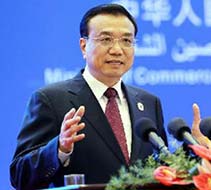
China, the world’s second largest economy (next to US) faces an ebbing of economic growth, which analysts caution may not be over soon. The country’s swift economic rise (averaging an economic expansion of 10% a year over the past three decades) has become an iconic growth model for other economies.
According to reports, China’s growth slows down to 7%, and missing its target of 7.5%, due to a range of discordant conditions, from sluggish lending, a housing glutto weak global demand. In the last quarter of 2014, the country’s economy expanded to 7.2%, the weakest in 24 years; the expansion, which has been attributed to Government measures to wean the economy from a heavy reliance on investment and exports and towards consumption and services, may still appear hefty for many Western countries, but given that China has a quarter of the world's population, the figuremay be inadequate for the East Asian country.
For 2015, the International Monetary Fund (IMF) forecasts the country’s growth to reach 6.8%; theforecast figure is also projected to dive further to 6. 5% by 2016, according toAndrew Colquhoun, head of Asia-Pacific sovereign coverage at Fitch Ratings.
Amidst the speculations that China’s economy is taking a free fall, the Government is stepping up to clear any air of doubt.
Chinese Premier Li Keqiangtells markets that the economy has only slowed down and not crashing.
He said during the World Economic Forum held in late January in Davos, Switzerland that China's economy has entered a state of 'new normal', which he further described as merely gaining a momentum as economic reforms are being introduced.
According to Li, these reforms are aimed at boosting entrepreneurship, stimulate competition, and protect intellectual property, among other things. The slower growth is solid and stable, he said, adding that regional or systemic financial crises will not happen in China.
The downturn calls for China to look for other avenues to get back on track of target growth. With this so-called new normal of growth, which (some) multinational and local companies are slowly getting accustomed to, businesses are up for major adjustments: sales have declined, and streamlining of workforce has been reported by several companies.
To allay the problem with debts, the government shuns what it considers wasteful projects, and looks into assisting sectors (e.g., routing credit access) such as entrepreneurs and farmers; and projects such as infrastructure, transport, oil pipeline, which is likely to lead to higher growth.
However, reports say that the debt-laden companies are also the ones that have access to credit; conversely, bankers are cautious about extending loans to smaller companies for the lack of assurance of repayment.
Meanwhile, many firms in problem sectors, including the real-estate market, which accounts for some 25% of GDP if steel, cement and related industries are included-are hoping for easier credit conditionsto foster new business.
What is happening in China, which has a broad clout in the global economy, is also affecting other regions, directly and indirectly. For one, China accounts to almost 50% of the world’s GDP growth in 2013, much more than the US.
A buckling-up China economy will weigh down on economies exporting to China, such as Europe, Southeast Asia, Japan, and South Korea.
Countries like Australia, Brazil, and Canada, which rely in on commodity exports, could also witness negative impact on their GDP. Likewise, industries that largely benefit from the Chinese market may also feel the nudge of loss. For example, China, the world’s largest consumer of steel, iron ore, and coal may show weaker demand for these commodities, as a result of the downturn.
(PRA)































